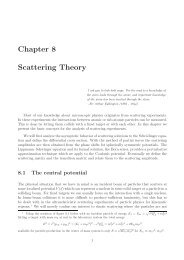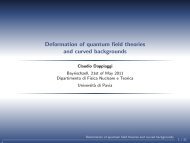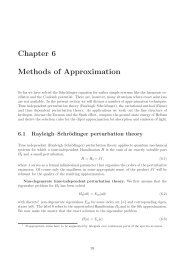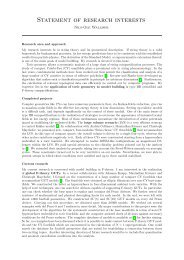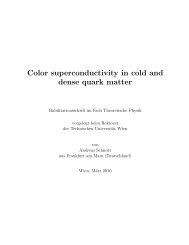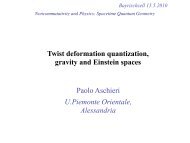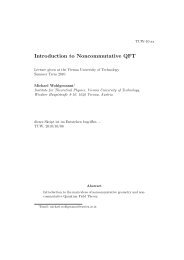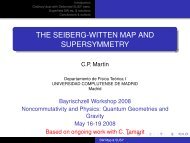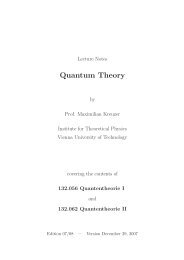Chapter 8 Scattering Theory - Particle Physics Group
Chapter 8 Scattering Theory - Particle Physics Group
Chapter 8 Scattering Theory - Particle Physics Group
You also want an ePaper? Increase the reach of your titles
YUMPU automatically turns print PDFs into web optimized ePapers that Google loves.
CHAPTER 8. SCATTERING THEORY 144<br />
where<br />
and<br />
A l (k) = [B 2 l (k) + C 2 l (k)] 1/2 (8.60)<br />
δ l (k) = − tan −1 [C l (k)/B l (k)]. (8.61)<br />
The δ l (k) are called phase shifts. We will see that they are real functions of k and completely<br />
characterize the strength of the scattering of the lth partial wave by the potential U(r) at the<br />
energy E = 2 k 2 /2m. In order to relate the phase shifts to the scattering amplitude we now<br />
insert the asymptotic form of the expansion (8.52) of the plane wave<br />
e i⃗ k⃗x<br />
=<br />
→<br />
∞∑<br />
(2l + 1)i l j l (kr)P l (cos θ). (8.62)<br />
l=0<br />
∞∑<br />
(2l + 1)i l (kr) −1 sin<br />
l=0<br />
(<br />
kr − lπ )<br />
P l (cos θ). (8.63)<br />
2<br />
into the scattering ansatz (8.20)<br />
u as<br />
⃗ k<br />
(r,θ) → e i⃗ k⃗x + f(k,θ) eikr<br />
r . (8.64)<br />
With sin x = (e ix −e −ix )/(2i) and the partial wave expansions (8.26)–(8.27) of u(⃗x) and f(θ,ϕ)<br />
we can write the radial function R l (k,r), i.e. the coefficient of P l (cos θ), asymptotically as<br />
(<br />
Rl as (k,r) = (2l + 1)i l (kr) −1 sin kr − lπ )<br />
+ 2l + 1 e ikr f l (k) (8.65)<br />
2 r<br />
= 2l + 1 ( ) )<br />
e<br />
(i l ikr<br />
− e−ikr<br />
+ 2ike ikr f<br />
2ikr i l (−i) l l (8.66)<br />
Rewriting (8.59) in terms of exponentials<br />
Rl as (k,r) = A (<br />
l e<br />
i(kr+δ l<br />
)<br />
)<br />
− e−i(kr+δ l)<br />
2ikr i l (−i) l<br />
(8.67)<br />
comparison of the coefficients of e −ikr implies<br />
A l (k) = (2l + 1)i l e iδ l(k) . (8.68)<br />
The coefficients of e ikr /(2ikr) are (2l + 1)(1 + 2ikf l ) and A l e iδ l /i l , respectively. Hence<br />
f l (k) = e2iδ l(k) − 1<br />
2ik<br />
= 1 k eiδ l<br />
sin δ l . (8.69)<br />
The scattering amplitude<br />
f(k,θ) =<br />
∞∑<br />
l=0<br />
(2l + 1)f l (k)P l (cos θ) = 1<br />
2ik<br />
∞∑<br />
(2l + 1)(e 2iδ l<br />
− 1)P l (cos θ) (8.70)<br />
l=0




